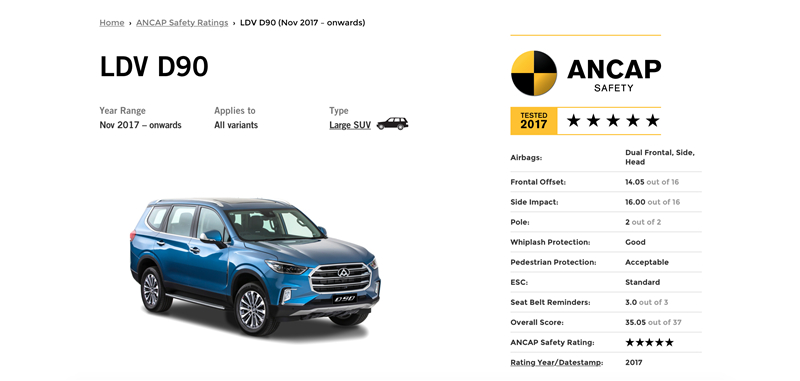D90 gains five stars at ANCAP tests

The Maxus SUV D90 produced by SAIC Motor Corporation Limited recently gained a five star safety rating in crash testing under the Australia New Car Assessment Program (ANCAP), the first Chinese Pickup vehicle model to do so.
The Maxus SUV D90 and Maxus Pickup T60 both won the highest scores at the crash tests among all Chinese brands for their own vehicle models, demonstrating the high production quality of SAIC Motor and promoting the international image of Chinese brands.
D90’s performance in ANCAP tests
ANCAP is one of the strictest programs for automobiles crash tests. Its star ratings indicate the level of safety a vehicle provides for occupants and pedestrians in the event of a crash, as well as its ability — through technology — to avoid or minimize the effects of a crash. ANCAP safety ratings are widely accepted around the world and provide safety references for vehicle buyers.
The test results of the D90 based on ANCAP safety ratings.
The safety performance of the D90 was thoroughly tested at ANCAP labs. After frontal offset and side impacts the car body still remained intact. Pole A and body structure were hardly deformed and the doors could be opened. The dummies remained fastened into the seats and well protected by airbags and air curtains on the front and sides.
The detailed score of each test:
Frontal Offset: 14.05 out of 16
Side Impact: 16.00 out of 16
Pole: 2 out of 2
Whiplash Protection: Good
Pedestrian Protection: Acceptable
Seat Belt Reminders: 3.0 out of 3
Overall Score: 35.05 out of 37
How did the D90 achieve five stars?
The five-star ratings of the Australia-New Car Assessment Program, used in China, are the highest automobiles crash test standards.
The results were predictable as the D90 was designed and produced in line with the five-star standards of ANCAP and the China-New Car Assessment Program. The vehicle’s outstanding active and passive safety systems guarantee that the D90 can provides qualified safety protection for drivers, passengers and pedestrians.
Body structure is the key to safety protection. To minimize the risk of causing injuries to passengers, 70 percent of the D90 body is made of high-strength steel, and 9 percent is of thermoformed steel with strength of 1,500Mpa, creating incomparable solid safety protection. Key components were also carefully designed and made of suitable materials, which can reduce and absorb the force of impacts and guarantee maintenance of the passenger compartment. Laser welding technology was also employed to bind the car roof to the body.
The safety system inside the cabin is also vital to protection. The safety belt is the basic protection method. The D90 automatically reminds passengers to ”buckle up” if they forget. There is also a pre-fasten function by which the belts at the driver and co-pilot positions can fix the passengers to the seats when the sensors send out the message that the car speed has changed upon impact. The vehicle is installed with a large sized air curtain which can unfold into a soft “bed” protecting all the passengers from striking hard surfaces. The D90 also has a comfortable and safe child seat.
Its high-standard electronic configuration can also help the car avoid dangers. The electronic stability program (ESP), antilock brake system (ABS), electric brake-force distribution (EBD), traction control system, and hydraulic break assist (HBA) can protect the car from the risk of going out of control on slippery roads, in prolonged turns, or when overtaking. The safe driving assistance system which includes adaptive cruise control (ACC), lane keeping assistance (LKA), lane departure warning (LDW) and forward collision warning can help the drivers concentrate on driving. Other functions, such as tire pressure monitoring, panoramic reversing camera viewing and blind spot monitoring, are also important.
Thanks to its commitment to high safety performance, SAIC Maxus has become a competitive international automobiles brand. It sold more than 7,400 vehicles in overseas markets from January to November in 2017, a year-on-year increase of 20 percent. The sale volume in Australia, New Zealand and Fiji surpassed 3,600 units, or 49.2 percent of the total number of non-domestic sales.
SAIC Motor insists on producing automobiless of high quality and performance to promote its brand around the world.
Further reading on ANCAP
Various new Car Assessment Programs (NACPs) provide efficient appraising of automobiles safety performances evalsuated from perspectives of vehicle collision, pedestrian protection and whiplash. There are nine assessment systems around the world – Euro-NCPA, Euro-NCAP, U.S.NCAP, IIHS (US; Insurance Institute for Highway Safety), Latin NCAP, JNCAP, C-NCAP, KNCAP, ASEAN NCAP, and ANCAP.
ANCAP ratings are determined by a series of internationally recognized, independent crash tests and safety assessments involving a range of destructive physical crash tests, an assessment of on-board safety features and equipment, and performance testing of active collision avoidance technologies. The major test procedures include frontal offset, side impact, pole impact, pedestrian protection and whiplash protection.
The ratings are determined based on the following standards. The percentages are the proportions of passengers who would receive serious injury upon impact:
Five star: no more than 10 percent;
Four star: 11 to 20 percent;
Three star: 21 to 35 percent;
Two star: 36 to 45 percent;
One star: more than 45 percent.

